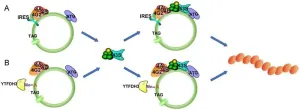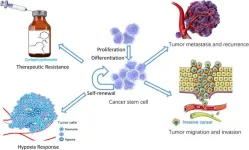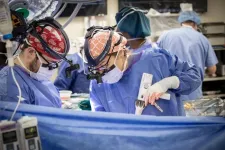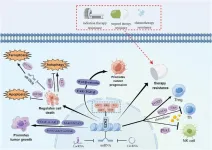(Press-News.org)
Tokyo, Japan – The XRISM collaboration have discovered flows of hot gas in the core of the Centaurus Cluster. By comparing state-of-the-art X-ray measurements from the XRISM satellite with numerical simulations, they showed this is evidence for collisions between galaxy clusters, causing gas inside to “slosh”. This solves the longstanding mystery of how cluster cores stay hot, and sheds light on how our universe continues to evolve.
Astronomers have long envisioned how vast gravitational forces between galaxies and galactic clusters, colossal cosmic assemblies bound by dark matter, drive their growth through mergers and collisions. However, direct evidence for this has been lacking.
The international XRISM (X-ray Imaging and Spectroscopy Mission) collaboration has observed the Centaurus galaxy cluster with the XRISM satellite, launched in 2023 by the Japan Aerospace Exploration Agency (JAXA); the on-board spectrometer, called Resolve, features groundbreaking precision spectroscopy, allowing accurate identification of gas velocities.
Looking at the core of the Centaurus Cluster, including the central galaxy NGC 4696, they discovered for the first time a bulk flow of hot gas traveling around 130 to 310 kilometers per second in the line-of-sight from Earth. They were also able to create a map of how the velocity varies at locations away from the center. Making comparisons with simulations, a task team led by Professor Yutaka Fujita from Tokyo Metropolitan University and Associate Professor Kosuke Sato from the High Energy Accelerator Research Organization found that this is consistent with the “sloshing” of the hot gas, also known as the intracluster medium (ICM), caused by collisions with other galactic clusters. This is the first direct evidence for this kind of “sloshing”, validating a long-hypothesized picture of the evolution of the universe.
It also solves a long-standing unsolved mystery for astronomers of how such bright X-ray emitting gas stays hot. Theoretically, such intense radiation should entail a loss of energy, leading to cooling of the gas; this is known as radiative cooling. The time scale over which this cooling should occur is shorter than the age of the cluster, but observations so far suggest that, somehow, the gas manages to stay hot. These new findings present an elegant solution to this problem. If the gas in the cluster core can “slosh,” involving vast bulk flows of gas to-and-fro around the center, energy can be transported to the core through a mixing process, keeping the gas hot and the emissions bright. The team’s breakthroughs have now been published in the scientific journal Nature.
These unprecedentedly precise measurements are a significant leap forward in our understanding of the formation and evolution of galactic clusters. With years still left in the XRISM mission, the world of astrophysics eagerly awaits more insights into the changing nature of the universe.
This work was supported by JSPS KAKENHI Grant Numbers JP22H00158, JP22H01268, JP22K03624, JP23H04899, JP21K13963, JP24K00638, JP24K17105, JP21K13958, JP21H01095, JP23K20850, JP24H00253, JP21K03615, JP24K00677, JP20K14491, JP23H00151, JP19K21884, JP20H01947, JP20KK0071, JP23K20239, JP24K00672, JP24K17104, JP24K17093, JP20K04009, JP21H04493, JP20H01946, JP23K13154, JP19K14762, JP20H05857 and JP23K03459, NASA (Grant Numbers 80NSSC23K0650, 80NSSC20K0733, 80NSSC18K0978, 80NSSC20K0883, 80NSSC20K0737, 80NSSC24K0678, 80NSSC18K1684 and 80NNSC22K1922), the National Science Foundation Award 2205918, the Science and Technology Facilities Council Grant ST/T000244/1, the Canadian Space Agency Grant 18XARMSTMA, the Kagoshima University Postdoctoral Research Program (KU-DREAM), the RIKEN SPDR Program, the Alfred P. Sloan Foundation through the Sloan Research Fellowship, the RIKEN Pioneering Project Evolution of Matter in the Universe (r-EMU), the Rikkyo University Special Fund for Research (Rikkyo SFR), and the GAČR EXPRO (Grant Number 21-13491X). Part of this work was performed under the auspices of the US Department of Energy by Lawrence Livermore National Laboratory under contract DE-AC52-07NA27344. The material is based on work supported by NASA under award number 80GSFC21M0002. This work was also supported by the JSPS Core-to-Core Program (JPJSCCA20220002). The material is also based on work supported by the Strategic Research Center of Saitama University.
END
Incidents of children in the U.S. being poisoned by the synthetic opioid fentanyl “increased and became more severe”, a new study reveals.
Launched today as Congress continues to review the HALT Fentanyl Act, the research follows an analysis of nonfatal fentanyl pediatric (aged 0-19) exposures reported to poison centers in 49 U.S. states from 2015 through to 2023.
In total, some 3,009 cases were detailed across the eight-year period.
In 2023 alone, 44.6% were life-threatening incidents in which there was extreme harm ...
Humans may not be the only ones who aid their friends when they’re hurt. Mice may do it, too, as shown by a new research study led by scientists at the Keck School of Medicine of USC published recently in Science.
Scientists have been trying to understand why social mammals appear to help injured members of their species. There are numerous factors that determine empathetic behavior and social bonding in mammals, said Li Zhang, the principal investigator of the study and professor of physiology and neuroscience ...
An ambitious project led by Vanderbilt University Medical Center investigators aims to use artificial intelligence technologies to generate antibody therapies against any antigen target of interest.
VUMC has been awarded up to $30 million from the Advanced Research Projects Agency for Health (ARPA-H) to build a massive antibody-antigen atlas, develop AI-based algorithms to engineer antigen-specific antibodies, and apply the AI technology to identify and develop potential therapeutic antibodies.
ARPA-H is an ...
A new review article highlights the transformative role of circular RNA (circRNA) in cancer, revealing its potential as both a key player in tumor biology and a promising avenue for future therapies. Once thought to be noncoding RNA, circRNA has now been shown to encode functional proteins, challenging conventional RNA biology and opening up novel therapeutic possibilities.
Unlike traditional messenger RNA, circRNAs form a continuous loop, lacking the typical 5' cap and 3' tail. This unique structure was originally believed to preclude them from protein translation. However, recent discoveries demonstrate that specific internal ribosome entry sites (IRES) and N6-methyladenosine ...
Lung cancer remains one of the leading causes of cancer-related mortality, with lung adenocarcinoma (LUAD) and lung squamous cell carcinoma (LUSC) representing the most prevalent subtypes of non-small cell lung cancer (NSCLC). Despite their classification under the same umbrella, these two forms of lung cancer exhibit distinct genetic landscapes, therapeutic targets, and treatment responses.
Recent advancements in next-generation gene sequencing have identified key driver genes that differentiate LUAD and LUSC, influencing their respective clinical management approaches. LUAD is frequently associated ...
A study published March 6 in The Lancet Regional Health — Americas highlights a growing divide in cardiovascular health in the U.S., showing that wealth and education play a significant role in heart disease risk.
The research, led by Salma Abdalla, MBBS, DrPH, an assistant professor of public health at Washington University in St. Louis, reveals that the top 20% of high-income, college-educated Americans have far lower rates of cardiovascular disease than the rest of the population — disparities ...
This review highlights the critical role of ubiquitination in governing the functionality of cancer stem cells (CSCs), shedding light on potential therapeutic targets for combating tumor progression, recurrence, and drug resistance. Published in Genes & Diseases, this article explores the intricate mechanisms through which the ubiquitin (Ub) system regulates key pathways essential for CSC maintenance and survival.
Ubiquitination, a fundamental post-translational modification, plays a pivotal role in protein stability, cellular signaling, and gene expression, particularly in the context of CSCs. Dysregulation ...
A new review highlights the pivotal role of LSD1 (lysine-specific demethylase 1) in regulating critical cellular processes and its implications for human diseases. This article sheds light on how post-translational modifications (PTMs) influence LSD1 activity, impacting its function in gene regulation and disease progression.
LSD1 is a histone demethylase that plays a significant role in chromatin remodeling and gene expression by modifying histone H3 lysine residues. It interacts with various protein complexes, allowing it to serve as both a transcriptional activator and repressor. The intricate modifications ...
Surgeons and teams with Vanderbilt Lung Transplant performed 99 lung transplants in 2024, the most ever in one year. Two of the procedures involved combined organ transplants.
For the second calendar year in a row, Vanderbilt Lung Transplant has the busiest program in the Southeast and leads the nation in innovation in organ preservation and regeneration.
The Vanderbilt Transplant Center is now home to the nation’s eighth largest lung transplant program by volume, and is among the best in long-term outcomes, demonstrating the ...
The critical role of EZH2, an essential epigenetic regulator, in cancer progression and treatment is underscored in this new review article published in Genes & Diseases. The study highlights the transformative potential of EZH2 inhibition, paving the way for a new generation of targeted therapies aimed at disrupting tumor growth and overcoming treatment resistance.
EZH2, a core component of the Polycomb Repressive Complex 2 (PRC2), plays a fundamental role in silencing tumor suppressor genes through histone methylation. Its overexpression has been ...







